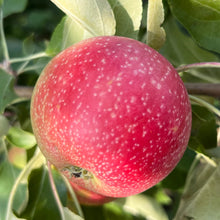
This year we are offering bare root dormant apple trees. Bare root trees need to be planted within a day or two of when you pick them up from us so they don't dry out. The advantages to bare root trees are that they don't experience transplant shock when they are planted, they are easier to transport, and we can offer them at a lower price than potted trees. The trees are two years old and are 5 to 7 feet tall with multiple branches. They will possibly bear a small amount of fruit this year and should produce a nice crop next year.
All of the apples trees are Semi-Dwarf trees. Semi-Dwarf trees will grow to between 13 and 15 feet tall. These trees will need to be staked or supported for the first two years. (We do offer metal posts and tree ties for purchase here.)
Apple trees do need a second variety for pollination. However, if you live in a city or suburban area there are plenty of crabapple trees in your area to provide pollination so you can buy just one variety. If you live in an isolated area with no other houses nearby it is probably a good idea to have a second tree for pollination if you haven't seen any other apple trees nearby.
These trees will be available starting Friday, May 9th for pickup at the farm. We are sorry but we are unable to ship trees. We are offering the following varieties of apples this year. They are listed in the order of when they ripen.
Pristine: One of the best early-season apples, Pristine is literally a "golden apple." It's skin is a beautiful lemon yellow. Tree bears crops of medium-to-large fruit with a sweet-tart taste and a crisp, breaking flesh. It is immune to apple scab and resistant to powdery mildew making it a good choice for organic growing. Ripens in early August.
Zestar: Is a great early season apple, ripening late August to early September. It was developed by University of MN apple breeding program and released in 1999. It is a very pretty, round, rosy red apple. The flesh is juicy and crisp, with a sprightly zest (hence its name). Zestar has an extended harvest time and requires a couple of pickings, making it a great apple for the home orchard.
KinderKrisp: This is my new favorite apple. :) It has exceptional flavor and crisp texture, like its parent Honeycrisp, but features small, snack size fruit. I find that a lot of apples are too big for one person to eat. KinderKrisp is the perfect size in my opinion. Was developed by David MacGregor of Fairhaven Farm near St. Cloud so is well adapted to Minnesota growing conditions. Also it isn’t susceptible to many of the common pests and diseases that affect other varieties, so it's great for organic growing. Ripens in late August.
Triumph: Brand new release from the University of MN! This is the first year this apple is available to plant. Is named Triumph because it is highly resistant to two common apple diseases, apple scab and cedar-apple rust. And it also has Honeycrisp as one of its parent trees, so it has that well balanced flavor with crisp texture we all love about Honeycrisp. Ripens in Mid-September.
Honeycrisp: Is the most famous of the many apples developed by the University of MN apple breeding program. It has achieved international fame and rock-star popularity on account of its exploding crispness; the flesh bursts open with a spray of juice that is refreshingly sweet and balanced. Ripens in mid-September.
Liberty: The tree is vigorous, easy to grow, and productive. It is resistant to fireblight and powdery mildew, and highly resistant to scab and cedar-apple rust. It is, basically, the perfect apple for the first-time or organic grower! It is not as well known in Minnesota because it was not developed by University of MN apple breeding program. The apple is medium sized, dark red in color, with yellow, creamy flesh. It has thicker skin (helpful with disease resistance) and a crisp bite. The fruit is juicy with a sweet/tart flavor. It ripens in early October.
SnowSweet: Savory, sweet tasting apple, with a slight tart balance and rich overtones. It has a unique characteristic that man people love. The fruit's snowy white flesh is very slow to oxidize and turn brown after cutting which makes it an excellent apple to slice for snack trays and salads. It ripens in early October. Was developed by the University of MN and released in 2006.























